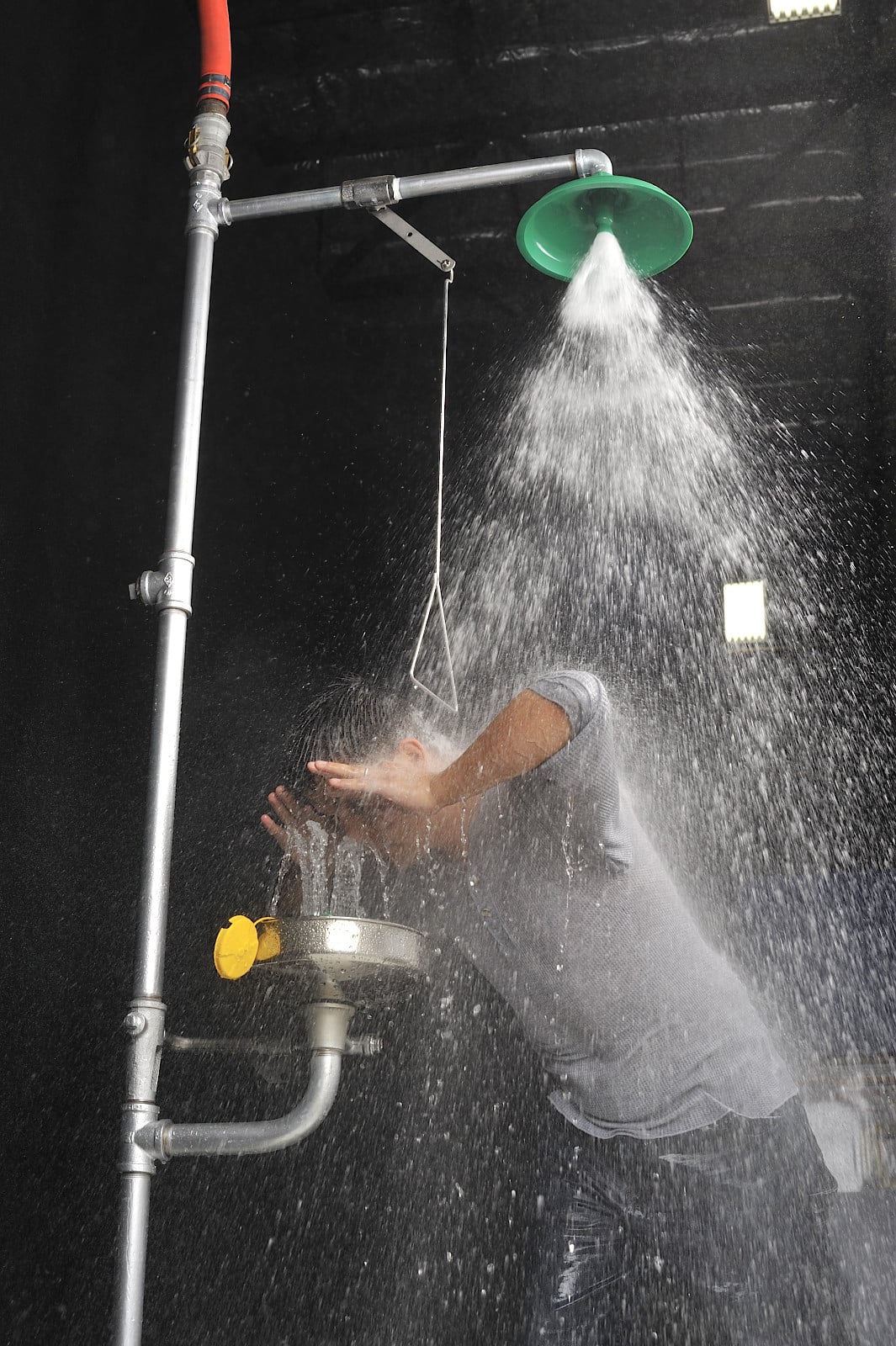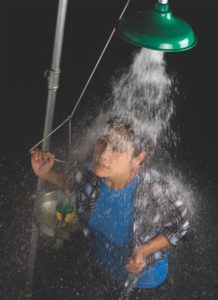There is no such thing as being too safe when experimenting in the laboratory. Follow these 6 easy steps to practice safe housekeeping in the laboratory.
1. Determine potential hazards. Be prepared for hazards that may likely happen by starting to review what has recently changed in the laboratory. If a change releases a trigger, that trigger then reveals that the specified change needs further examination. Document the change so that the potential hazard is universal among others in the laboratory.
2. Familiarize yourself with the equipment you will be working with. After identifying potential hazards, notice if there are new tools that have been added to the laboratory. Before using the new tool, be aware of the functionality of the tool and the implied hazard that could be associated with it. Properly alert other members of the lab, to make sure they are all up to speed on the new piece of equipment.
3. Read through the MSDS (Material Safety Data Sheet) on site. If you are unsure of a chemical in the lab, the MSDS should have the information that you need. Whether it be how to properly dispose of a chemical, or use of the chemical, the MSDS will properly guide you to the safe and appropriate method. The MSDS is composed of distinct sections for quick and easy reference.
4. Dress in appropriate gear. Upon entering the lab, there is no excuse to wearing open-toed shoes or not wearing a lab coat to protect against spilled chemicals. Hair should be pulled away from face, safety goggles secured, and safety gloves should be worn.
5. Test emergency showers and eyewashes. By ANSI Z358.1 standard, it is a requirement to test emergency eyewashes and showers on a weekly basis. In the case of an accident in the laboratory, the shower or eyewash should sustain a full 15-minute drench period in water that is between 60°F – 100°F and be sediment free.
6. Thoroughly clean following an experiment. Publish a checklist for the lab that lists the steps to insuring the lab is properly cleaned after the experiment is performed. Be clear on where tools must be properly stowed, that surfaces are wiped clean, and emergency equipment is obstruction free. Designate a safety lead to direct the clean up.
If your laboratory is in need of new safety equipment, check out this lab products brochure.
Safety Tip: The Importance of Tempered Water for Victim ComfortIn the morning before hopping into the shower, you may overestimate how low your body temperature is and turn the shower dial to the hottest that it will reach. You then step your entire body into the water and react to the scalding hot water by stepping away from the water, and turning the dial to a lower temperature. Unfortunately in an emergency situation, you are not given the chance to adjust the temperature of flowing water. Emergency eyewashes and emergency showers can be the solution to mitigating an injury while on the job. But if the equipment produces water that is either too hot or too cold and does not comply with ANSI Z358.1, the injury could possibly be made worse.  Water temperature should range from 60° to 100° F (15.5° C to 37.7° C) throughout the entire 15 minute drench or irrigation cycle. When showering at your home shower, the temperature should rest around 105° F (40.5° C). Room temperatures range around 68° F to 70° F (20 °C to 21.1°C), so it is important to consider victim comfort when running water temperature in an emergency shower or eyewash. If the temperature should fall around the lower range of the ANSI requirement, the victim may not feel comfortable through the duration of the cycle. A thermostatic mixing valve that regulates temperature spikes is fitting in making sure temperature stays controlled.
Water temperature should range from 60° to 100° F (15.5° C to 37.7° C) throughout the entire 15 minute drench or irrigation cycle. When showering at your home shower, the temperature should rest around 105° F (40.5° C). Room temperatures range around 68° F to 70° F (20 °C to 21.1°C), so it is important to consider victim comfort when running water temperature in an emergency shower or eyewash. If the temperature should fall around the lower range of the ANSI requirement, the victim may not feel comfortable through the duration of the cycle. A thermostatic mixing valve that regulates temperature spikes is fitting in making sure temperature stays controlled.  The victim is the number one priority in emergency situations, and you want the victim to abide by flush requirements in order to alleviate the injury. If the temperature is uncomfortable to the victim, the victim will feel pressure to leave the shower which may exacerbate the injury. We want the victim to feel comfortable, and once the victim does find comfort, he or she is more likely to remove contaminated clothing to boost the wash objective. Tempered water is a crucial factor to consider for victim comfort. Avoid legal repercussions and test your emergency shower and eyewash’s temperature regularly! Read more about ANSI Z358.1 requirements here.
The victim is the number one priority in emergency situations, and you want the victim to abide by flush requirements in order to alleviate the injury. If the temperature is uncomfortable to the victim, the victim will feel pressure to leave the shower which may exacerbate the injury. We want the victim to feel comfortable, and once the victim does find comfort, he or she is more likely to remove contaminated clothing to boost the wash objective. Tempered water is a crucial factor to consider for victim comfort. Avoid legal repercussions and test your emergency shower and eyewash’s temperature regularly! Read more about ANSI Z358.1 requirements here.
To sustain an injury-free workplace is a goal that safety managers actively work to reach. A safe environment to work in can be attributed to having a safety leader with valuable leadership characteristics. For safety to be properly executed in the work environment, there must be a leader who has engaging power with his or her employee and have the intrinsic motivation for a safe workplace in order to effectively reach to employees. Some key characteristics include:
1. Always consider the perspective of each employee. Safety has a different meaning to each individual. The safety lead is going to handle safety differently than a frontline worker. A safety lead must take charge of the security of those that work underneath him or her. A frontline worker is in charge of his or her own safety. Find out what motivates employees to stay safe in the workplace to build a safety program.
2. Build Motivation. Once you find out what motivates your employees to stay safe in the workplace, build a program designed around their motivation. Find out what the best method is to motivate each individual employee. It could be in the form of safety meetings, forming a task – work group, or coaching employees on safety tips.
3. Actively Participate. It is crucial as a safety leader to sustain participation amongst employees. Keep an eye out for new ideas and tactics to have a continually safe workplace. A safety leader is highly effective when there is constant innovation with techniques involving safety.
[Via: Safety and Health]
Safety Tip: Product SuitabilityIs your facility in need for new emergency equipment? Before investing the time and money in buying new equipment, it is critical that the correct product is sought after. Perhaps you work at a chemical plant and the risk of hazardous chemicals to be splashed in the facial area is high. The best solution in this case is an eye/face wash rather than just an eyewash that will only cleanse the eyes and not the face as well. Chemical reach may not only harm the eye area, which is why an eye/face wash is the best solution.
Once you have identified the proper type of equipment to invest in, refer to the ANSI Z358.1 standard for training, testing, installation, maintenance, location, and use. Here is a quick reference guide to what is expected out of each category of emergency equipment:
- Eyewash: Efficient to injuries affecting only the eyes. Must have a simultaneous, uninterrupted, and controlled flow to both eyes.
- Eye/face wash: Risk of injuries include the entire face as well as eyes. Must have a large enough dispensation of water to reach both the eyes and face.
- Emergency shower: Used when a greater area of the body is at risk of injury. Water must cover a larger portion of the body and can also be used simultaneously with an eye wash or eye/face wash.
Find the emergency equipment that best suits your workplace here!







